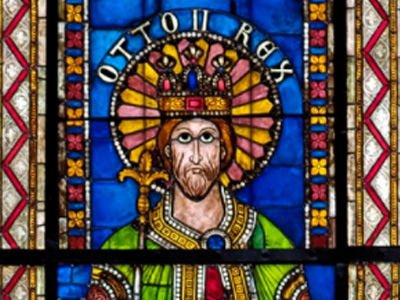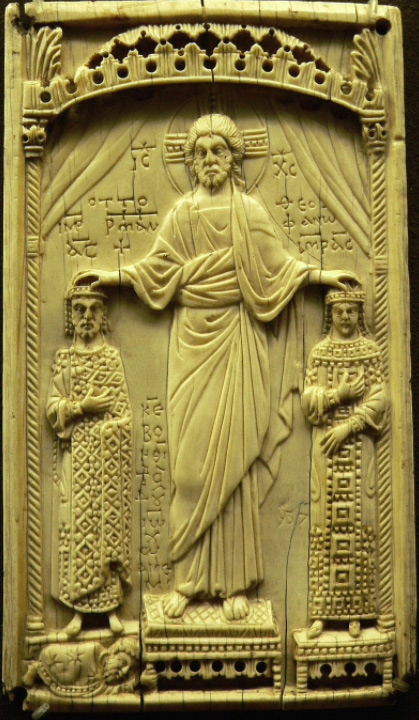Otto II, Holy Roman Emperor (955-983)
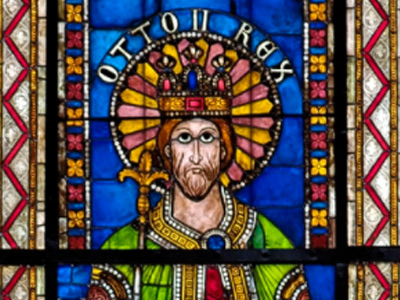
Imperial Crisis
Succession Issues
The defeat at Stilo forced Otto II to flee north to Rome. He then held an Imperial Diet at Verona on Pentecost, 983. He sent his nephew Otto I, Duke of Swabia and Bavaria, back to Germany with the news of the defeat and to call the German nobles to the assembly, but he died en route on November 1, 982, in Lucca. News of the battle did cross the Alps, however, reaching as far as Wessex in Britain, signifying the magnitude of the defeat. Duke Bernard I of Saxony was heading south for the assembly when Danish Viking raids forced him to return to face the threat.
At the assembly, Otto II appointed Conrad (a distant relative of Otto II) and Henry III as the new Dukes of Swabia and Bavaria respectively. Henry III had previously been exiled by Otto II following his defeat as part of a two-year revolt against Otto II's rule. The defeat at Stilo cost the Empire many nobles, forcing Otto II to lift the banishment of Henry III in order to stabilize domestic affairs in Germany while he campaigned against the Muslim and Byzantines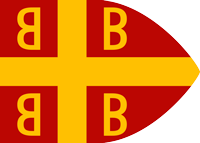 The Byzantine Empire, also referred to as the Eastern Roman Empire or Byzantium, was the continuation of the Roman Empire primarily in its eastern provinces during Late Antiquity and the Middle Ages, when its capital city was Constantinople. It survived the fragmentation and fall of the Western Roman Empire in the 5th century AD and continued to exist for an additional thousand years until the fall of Constantinople to the Ottoman Empire in 1453. in southern Italy. Also, the appointment of Conrad I allowed the House of the Conradines to return to power in Swabia for the first time since Emperor Otto I in 948. Otto II and the assembled nobles agreed on a strategy of naval blockade and economic warfare until reinforcement from Germany could arrive. Otto II then prepared for a new campaign against the Muslims and obtained a settlement with the Republic of Venice, whose assistance he needed following the destruction of his army at Stilo. However, the death of Otto II the next year and the resulting civil war prevented the Empire from appropriately responding to the defeat.
The Byzantine Empire, also referred to as the Eastern Roman Empire or Byzantium, was the continuation of the Roman Empire primarily in its eastern provinces during Late Antiquity and the Middle Ages, when its capital city was Constantinople. It survived the fragmentation and fall of the Western Roman Empire in the 5th century AD and continued to exist for an additional thousand years until the fall of Constantinople to the Ottoman Empire in 1453. in southern Italy. Also, the appointment of Conrad I allowed the House of the Conradines to return to power in Swabia for the first time since Emperor Otto I in 948. Otto II and the assembled nobles agreed on a strategy of naval blockade and economic warfare until reinforcement from Germany could arrive. Otto II then prepared for a new campaign against the Muslims and obtained a settlement with the Republic of Venice, whose assistance he needed following the destruction of his army at Stilo. However, the death of Otto II the next year and the resulting civil war prevented the Empire from appropriately responding to the defeat.
The most important action taken by Otto II at the assembly, however, was to secure the "election" of his son Otto III, who was then only three years old, as King of Germany and heir apparent to the Imperial throne. Otto III thus became the only German king elected south of the Alps. The exact reason for this unusual procedure has been lost to history. It is possible that the conditions in southern Italy following the defeat required Otto II to act quickly in designating an Imperial heir to ensure connivance in the Empire's future. It is also conceivable, however, that holding the election in Italy was a deliberate choice on the part of Otto II in order to demonstrate that Italy was an equal part of the Empire on the same level as Germany. His election secured, Otto III and his mother, the Empress Theophanu, traveled north across the Alps heading for Aachen, the traditional coronation site for the Ottonians, in order for Otto III to be officially crowned as king. Otto II stayed in Italy to further address his military campaigns.
Great Slav Uprising
Around the year 982, Imperial authority in Slavic territory extended as far east as the Lusatian Neisse River and as far south as the Ore Mountains. Following the defeat of Otto II at Stilo in 983, the Lutici Federation of Polabian Slavs revolted against their German overlords, sparking a great revolt known as the Great Slav Rising (Slawenaufstand). The Polabian Slavs destroyed the bishoprics of Havelberg and Brandenburg. According to the German chronicler Bishop Thietmar of Merseburg, the decades-long, forced Germanization and Christianization of the Slavs associated with these two churches was the reason for their destruction. Thietmar blames the uprising on maltreatment of the Slavs by the Germans: "Warriors, who used to be our servants, now free as a consequence of our injustices." In the Obotrite territories along the Elbe River, the Luticians initiated a revolt aimed at the abolition of feudal rule and Christianity, drawing upon considerable support by the Obodrite populace and their leader Mstivoj. In part, the Obrodite revolt was successful: The princely family, though in part remaining Christian, dissolved Christian institutions.
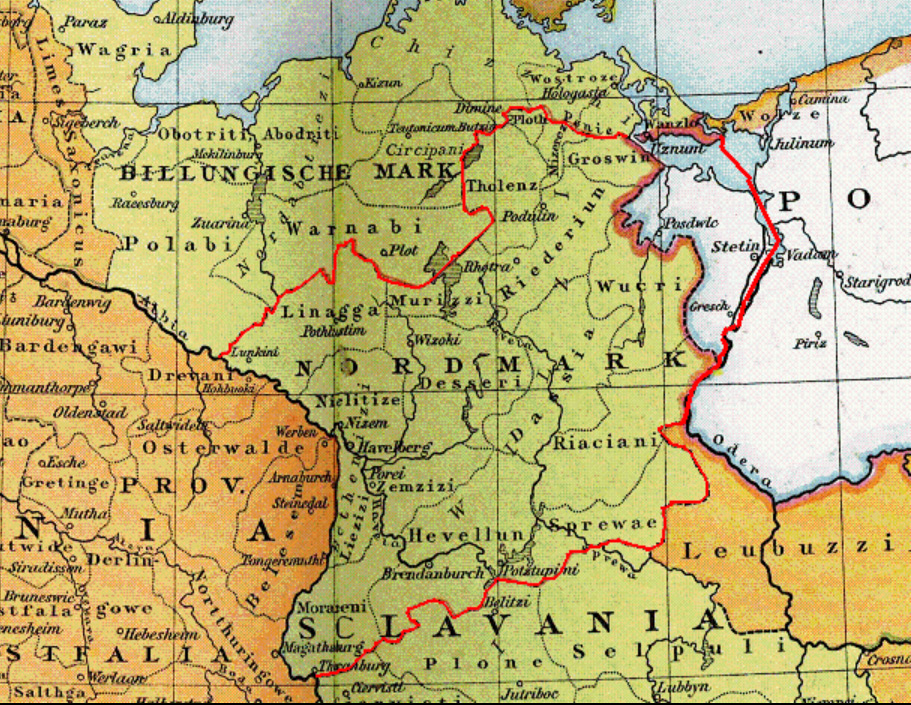
The Northern March (outlined in red) between the Billung March in the north and the Saxon Eastern March (March of Lusatia) in the south. Both the Billung March and the North March were lost following the Great Slav Rising.
Soldiers from the Northern March, the March of Meissen, the March of Lusatia, as well as from the Bishop of Halberstadt and the Archbishop of Magdeburg, joined forces to defeat the Slavs near Stendal. Nevertheless, the Empire was forced to withdraw to the western banks of the Elbe river. The successes of the Empire's Christianization policy towards the Slavs were nullified, and political control over the Billung March and the Northern March (territories east of the Elbe) was lost. In the decade since his death, Otto I's life work of converting the Slavs was undone. The Slavic territories east of the Elbe would remain pagan for over a century before further missionary work resumed: it would not be until the 12th century that the churches of Havelberg and Brandenburg would be reestablished.
The Danes took advantage of the Slavic revolt and invaded the March of Schleswig along the Empire's northern border while the Sorb Slavs invaded and conquered the March of Zeitz from Saxon control.
Sudden Death and Political Turmoil
In July 983, Pope Benedict VII, a longtime Ottonian supporter, died of natural causes after having reigned for almost ten years. Otto II returned to Rome in September to name a new Pope, selecting the Bishop of Pavia Pietro Canepanova (who reigned as Pope John XIV) in November or early December. While Otto II was in Rome overseeing the election of a new pope, a malaria outbreak in central Italy prevented the resumption of military activity in southern Italy. The outbreak ultimately led to the death of the Emperor himself: he died in his palace in Rome at the age of 28 on December 7, 983, after having reigned for just over a decade. Otto II's money and possessions were divided among the Catholic Church, the poor of the Empire, his mother Adelaide and sister Matilda, and those nobles loyal to him. Otto II was then buried in the atrium of St. Peter's Basilica.
Otto II's three-year-old son Otto III was crowned as King of Germany in Aachen on Christmas Day in 983, three weeks after his father's death. Otto III was crowned by Willigis, the Archbishop of Mainz, and John, the Archbishop of Ravenna. News of Otto II's death first reached Germany after Otto III's coronation. The unresolved problems in southern Italy and the Slavic uprising on the Empire's eastern border made the Empire's political situation extremely unstable. The arrival of a minor on the Imperial throne threw the Empire into confusion, allowing Otto III's mother, the Byzantine Princess Theophanu, to reign as his regent.
In 976, Otto II had deposed Henry II as Duke of Bavaria and imprisoned him. In early 984, Henry II escaped from his imprisonment by the Bishop of Utrecht. Free from his confinement, he seized the infant Otto III and, as a member of the ruling Ottonian dynasty, claimed the regency of the Empire for himself. Henry II eventually went so far as to claim the German throne outright, obtaining the allegiance of Mieszko I of Poland and Boleslaus II, Duke of Bohemia. Henry II's claims were supported by Archbishop Egbert of Trier, Archbishop Gisilher of Magdeburg, and Bishop Dietrich I of Metz. Otto III's right to the throne, however, was supported by Archbishop Willigis of Mainz and the Dukes of Saxony, Bavaria, and Swabia. The threat of war from Willigis and Conrad I, Duke of Swabia forced Henry II to relinquish Otto III on June 29, 984 and to respect the regency of Theophanu.
The early death of Otto II and the ensuing events proved to be a serious test for Empire. Despite having a child under the regency of his mother as a ruler, the structure established by Emperor Otto the Great remained strong as most of the Empire's most powerful officials stayed loyal to the Imperial system.
HISTORY
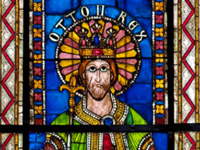
RESOURCES
This article uses material from the Wikipedia article "Otto II, Holy Roman Emperor (955-983)", which is released under the Creative Commons Attribution-Share-Alike License 3.0.
© Stories Preschool. All Rights Reserved.
